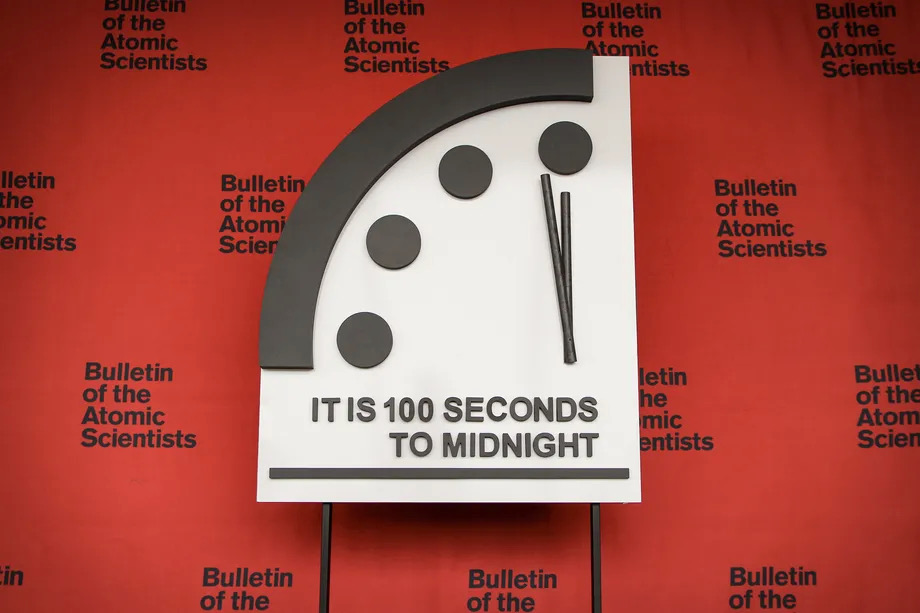By Nick Erickson
The Bulletin of the Atomic Scientists board, which George Washington University Research Professor Sharon Squassoni co-chairs, says that time to save humanity is ticking rapidly away—as in 100 seconds away from the end of civilization.
Each January, the board sets the minute hand of the Doomsday Clock, which measures just how close unchecked scientific, technological and societal advances are from rendering mankind obsolete. For the third straight year, the clock has remained at 100 seconds, dangerously close to a midnight Armageddon. This is the closest ever to midnight in the clock’s 75-year history.
“We ask ourselves two basic questions: Are we better off than we were last year? And where do we stand in the sweep of time?” Squassoni said.
The answers for 2022 are 1) not enough to move the needle and 2) apparently stuck in sand that could continue to sink at any moment.
“It’s time to really think smartly about how we are living and what we want to invest in,” said Squassoni, a nuclear expert in the Elliott School of International Affairs. She would also like to stress that this is a metaphorical assessment and that it serves as a warning, not projection.
The clock was born in the immediate aftermath of World War II, when scientists who helped develop the first atomic weapons for the Manhattan Project were galvanized to warn the public about the potential dangers of nuclear weapons. The first reading in 1947 checked in at seven minutes to midnight, when fear about the impact of nuclear weapons on world security was high. The clock was furthest from midnight in 1991 after the fall of the Soviet Union, the withdrawal of nuclear weapons by former President George H.W. Bush and former Soviet leader Mikhail Gorbachev, and the signing of the Strategic Arms Reduction Treaty pushed it back to 17 minutes to midnight.
It has drawn closer to midnight ever since, especially since 2007 when climate change became a part of the board’s assessment. The board, which Squassoni has been a part of since 2014, meets twice a year to assess the state of existential risk. There is no algorithm or measurement, Squassoni said, but rather expert judgements. Climate experts, nuclear weapons experts, biologists, journalists and former military members have all been on the board. Former Elliott School faculty member Allison Macfarlane was a previous board member.
This year’s number stayed put because potential factors that would move the needle one way or the other are still unknown. An example is the Nuclear Posture Review, which has not yet been completed by the Biden Administration. For context, nine countries have nuclear weapons, and the United States could soon be spending $60 billion a year on nuclear weapons. In other words, the threat of them likely isn’t going anywhere.
“When you spend that kind of money, it's really hard to decide to scrap them,” Squassoni said. “That conclusion is kind of inescapable.”
One of the board’s biggest concerns why the suspended needle is so dangerously close to midnight is disinformation campaigns that have taken off since the rise of 24-hour news networks and social media, which policymakers have used to their political advantage.
Squassoni said if basic facts are disagreed upon, it increases the difficulty of putting policies in place to combat manmade threats to the world.
“I think messaging and communicating is vital,” Squassoni said. “It’s hugely complicated by the misinformation, and the fact that lot of misinformation has been politically motivated provides another layer of complication.”
So, what would ultimately push the clock to midnight? A massive exchange of all nuclear weapons that ends civilization is possible but highly unlikely according to Squassoni. She instead sees a slow march primarily because of climate and public health crises, pointing to extreme weather events, greenhouse gas emissions and transmittable viruses as reasons for concern.
“It’s got to be different if we’re going to preserve the environment that makes our civilization enjoyable,” she said.
Squassoni did point out that the United States rejoined the Paris Climate Agreement and the World Health Organization. She also highlighted the quick creation of the COVID-19 vaccine that over 4 billion people have taken worldwide as another reason the needle didn’t move any closer this year.
“It’s funny because people call us the doom and gloom team, but fundamentally, we're also very optimistic,” she said. “I mean, the kind of ingenuity and technological sophistication and potential is tremendous. It just needs to be pushed in the right direction.”



